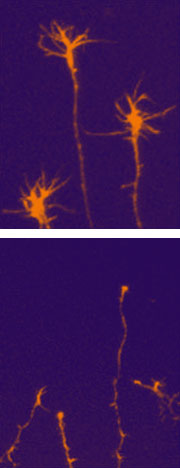Nogo, MAG and Omgp are myelin-derived proteins that limit axon regeneration in the central nervous system (CNS); they bind to a Nogo-66 receptor (NgR) to inhibit neuron outgrowth after injury to the CNS. Several studies have shown that neutralization of these inhibitors could improve axon regeneration, but none have achieved full axon recovery so far. Jian Zhang and co-workers at the Chinese Academy of Sciences in Beijing have identified a non-myelin-derived protein that inhibits neuron outgrowth. The finding suggests an alternative target for axon regeneration.
Zhang and co-workers knew that astrocytes become highly active in response to CNS injury or diseases. They also knew that astrocytes in patients with multiple sclerosis have upregulated expression of B-lymphocyte stimulator (BLyS), a protein indispensible for B-lymphocyte development. What they did not know, however, was the role of BLyS in axon regeneration.
The researchers used an expression-cloning approach to search for BLyS receptors in the CNS. They identified NgR as a binding receptor for it.
By binding to NgR, BLyS collapsed dorsal root ganglion axons and inhibited neuron outgrowth in culture (pictured bottom). The inhibitory effect of BLyS reversed when NgR was truncated or removed from neurons.
The researchers later found that mice with injury to the spinal cord have upregulated expression of both BLyS and NgR in astrocytes and macrophages at the damaged sites. They speculated that BLyS expression in astrocytes increases in response to injury to the spinal cord, and that locally secreted BLyS from astrocytes binds directly to NgR on neurons to regulate outgrowth. The results suggest that blocking BLyS and NgR interaction may be a necessary measure for successful axonal regeneration.

(Felix Cheung, Developmental neuroscience: The bliss of growth. Nature China,27 May 2009, doi:10.1038/nchina.2009.117)
Original article citation
Zhang, L. et al. Identification of BLyS (B lymphocyte stimulator), a non-myelin-associated protein, as a functional ligand for Nogo-66 receptor. J. Neurosci. 29, 6348–6352 (2009).



